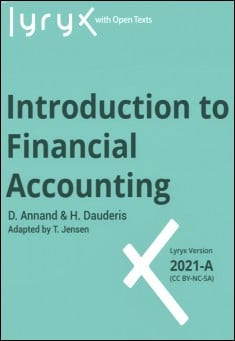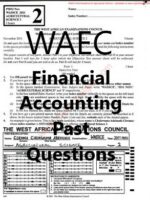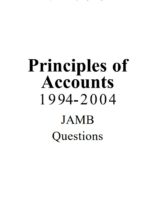Author: Henry Dauderis & David Annand. Adapted by T. Jensen
Book Synopsis (provided by the author)
This Open Source book is intended for a first course in introductory financial accounting. Introduction to Financial Accounting has been extensively edited by Athabasca University and reflects current International Financial Reporting Standards (IFRS). A corporate approach is utilized versus beginning with a sole proprietorship emphasis and then converting to a corporate approach. The textbook focuses on core introductory financial accounting topics that match pre-requisite requirements for students advancing to Intermediate Financial Accounting. Excluded are advanced topics that are covered in Intermediate Financial Accounting, such as leases and bond amortization. The textbook covers all essential topics, including: the accounting cycle; merchandising; assigning costs to inventory; cash and receivables; property, plant and equipment; debt financing; equity financing; statement of cash flows; financial statement analysis; and proprietorships and partnerships.
Excerpt:
Financial Statement Disclosure Decisions
Financial statements communicate information, with a focus on the needs of financial statement users such as a company’s investors and creditors. Accounting information should make it easier for management to allocate resources and for shareholders to evaluate management. A key objective of financial statements is to fairly present the entity’s economic resources, obligations, equity, and financial performance.
Fulfilling these objectives is challenging. Accountants must make a number of subjective decisions about how to apply generally accepted accounting principles. For example, they must decide how to measure wealth and how to apply recognition criteria. They must also make practical cost-benefit decisions about how much information is useful to disclose. Some of these decisions are discussed in the following section.
Making Accounting Measurements
Economists often define wealth as an increase or decrease in the entity’s ability to purchase goods and services. Accountants use a more specific measurement – they consider only increases and decreases resulting from actual transactions. If a transaction has not taken place, they do not record a change in wealth.
The accountant’s measurement of wealth is shaped and limited by the generally accepted accounting principles introduced and discussed in Chapter 1, including cost, the monetary unit, the business entity, timeliness, recognition, and going concern. These principles mean that accountants record transactions in one currency (for example, dollars). They assume the monetary currency retains its purchasing power. Changes in market values of assets are generally not recorded. The entity is expected to continue operating into the foreseeable future.
Economists, on the other hand, do recognize changes in market value. For example, if an entity purchased land for $100,000 that subsequently increased in value to $125,000, economists would recognize a $25,000 increase in wealth. International Financial Reporting Standards generally do not recognize this increase until the entity actually disposes of the asset; accountants would continue to value the land at its $100,000 purchase cost. This practice is based on the application of the cost principle, which is a part of GAAP.
Economic wealth is also affected by changes in the purchasing power of the dollar. For example, if the entity has cash of $50,000 at the beginning of a time period and purchasing power drops by 10% because of inflation, the entity has lost wealth because the $50,000 can purchase only $45,000 of goods and services. Conversely, the entity gains wealth if purchasing power increases by 10%. In this case, the same $50,000 can purchase $55,000 worth of goods and services. However, accountants do not record any changes because the monetary unit principle assumes that the currency unit is a stable measure.
Financial statements are focused primarily on the needs of external users. To provide information to these users, accountants make cost-benefit judgments. They use materiality considerations to decide how particular items of information should be recorded and disclosed. For example, if the costs associated with financial information preparation are too high or if an amount is not sufficiently large or important, a business might implement a materiality policy for various types of asset purchases to guide how such costs are to be recorded. For example, a business might have a materiality policy for the purchase of office equipment whereby anything costing $100 or less is expensed immediately instead of recorded as an asset. In this type of situation, purchases of $100 or less are recorded as an expense instead of an asset to avoid having to record depreciation expense, a cost-benefit consideration that will not impact decisions made by external users of the business’s financial statements.
Accountants must also make decisions based on whether information is useful. Is it comparable to prior periods? Is it verifiable? Is it presented with clarity and conciseness to make it understandable? Readers’ perception of the usefulness of accounting information is determined by how well those who prepare financial statements address these qualitative considerations.






Be the first to review “Introduction To Financial Accounting”